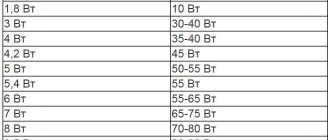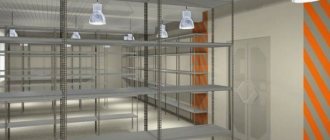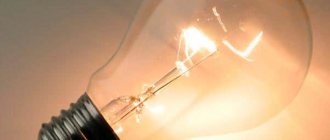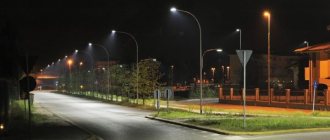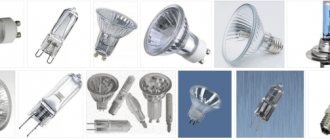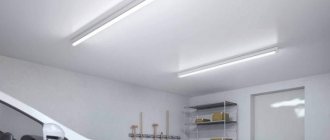Lighting device design
The design of any lighting device includes:
- parts of the electrical wiring intended to connect the device to the circuit;
- fittings are needed for fastening and protecting an artificial light source from mechanical damage and exposure to external factors (moisture, water, pressure, ultraviolet). Includes decorative elements and details designed to diffuse the flow of light;
- Light source;
- fasteners for installation.
Light complexes
A lighting complex is a device consisting of a set of lighting devices, individual light-redistributing or light-converting elements, structural, electrical and other parts, assembly units or blocks, assembled from the consumer, performing its functions only in assembled form and intended for lighting or signaling.
A luminous strip is a light complex, the ratio of the length of the luminous surface to its width is more than 5.
A luminous ceiling is a lighting complex, the dimensions of the luminous surface of which are comparable to the dimensions in terms of the illuminated room.
A slot light guide is a hollow, extended cylindrical or other shaped light-redistributing element of a light complex, most of the inner surface of which along its entire length is covered with a specularly reflective layer, while the luminous flux of the lamp is introduced into the end of the light guide and exits it along its entire length through that part of the surface that not covered with a reflective layer - a light-transmitting optical slit.
Classes of devices for creating artificial light
Description of the three main types of artificial lighting devices:
- spotlight – allows you to concentrate light beams in small solid angles. Designed for illuminating objects located at a great distance from the light source. For example, stadium lighting or high-beam car headlights;
- lamp - distributes the main flow of light from the device within large solid angles. The distance to the object should be commensurate with the size of the lighting device used. Installed for lighting both large and small objects;
- projector – distributes the entire light flux evenly. Installed to illuminate a strictly limited surface. Performance characteristics are ensured by the operation of a complex system of mirrors and lenses. The device falls into the category of lighting devices, but is mainly used for presentations. Not used for lighting in the usual sense.
Classification of lighting electrical installations.
Page 1 of 5Next ⇒
INTRODUCTION
Artificial lighting is of great importance for modern society. For a long time, the main artificial source of light was flame. Bonfire, torch, wick and oil lamps, wax and stearine lamps, kerosene lamps and gas jets - these were used for flame light sources, used in different eras.
In the past century, electric light sources - arc lamps and incandescent lamps -
Gave a strong impetus to the development of artificial light sources.
An outstanding role in the development and improvement of electric light sources belongs to Russian electrical engineers. In 1802 outstanding Russian scientist academician V.V. Petrov was the first to discover the phenomenon of an electric arc, which forms between two carbon rods when an electric current passes through them, and noted its luminous properties and electrical energy for lighting purposes. In 1872 The outstanding Russian inventor A.N. Lodygin created for the first time in the world an electric incandescent lamp, in which a carbon rod enclosed in an evacuated glass cylinder served as the filament body. Subsequently, samples of A.P. Lodygin’s lamps came to America to Edison, who improved their design and developed the technology for their production.
The development of gas-discharge lamps proceeded significantly slowly at first. Only 70 years after the discovery of the Petrov arc, the famous Russian inventor P.N. Yablochkov created the first practically suitable light source, which was an open carbon arc. Only in the 30s of the last century, based on a combination of a gas discharge with effective phosphors developed by that time, was it created gas-discharge light source, competitive with incandescent lamp - fluorescent lamp
A COMMON PART
2.1 Electric light sources.
The luminous flux of most light sources is distributed fairly evenly in space.
For rational lighting of a room or open space, it is usually necessary to distribute the luminous flux of the light source in a very specific way: direct it down or up. For such redistribution of the light flux, lighting devices are used.
Lamps are short-range lighting devices used to illuminate objects located at a short distance.
A spotlight, unlike lamps, is a long-range lighting device and is used to illuminate distant objects.
The lamp consists of a light source and lighting fixtures. The main purpose of lighting fixtures is to redistribute the luminous flux of the light source. It also protects the vision of workers due to excessive brightness of light sources, protects the lamp from mechanical damage, protects the cavities of the location of the light source and cartridge or environmental influences, and serves for fastening the light source, wires, and ballasts.
Optical systems of lighting devices are designed to redistribute the light fluxes of light sources. The elements of optical systems are: reflectors, refractors, diffusers, protective glasses, shielding grilles and rings.
Reflectors - redistribute the luminous flux of the lamp. Depending on the reflection, reflectors can be diffuse, matte or specular.
Diffusers - redistribute the luminous flux of the lamp based on diffuse transmission. There are diffuse, matte and frosted diffusers. The last two have directionally scattered transmission; Matted ones have less scattering power than matte ones.
Refractor - redistributes the luminous flux of the light source reflected from the reflector, redistributed using a diffuser or refractor. Certain types of lamps may not have a reflector or diffuser.
Modern electric light sources are incandescent, low-pressure fluorescent and high-pressure mercury lamps.
Incandescent lamps (Fig. 1), the most common electric light source, have a tungsten filament, most often a spiral one, located in a vacuum or inert gas.
| 1. base 2. glass leg. 3. filament. 4. glass flask. |
Fig 1. Incandescent lamp.
The principle of operation of incandescent lamps is based on the conversion of electrical energy supplied to its filament into the energy of visible radiation, affecting the human visual organs and creating a feeling of light close to white.
Incandescent lamps, from the internal volume (bulb) of which air has been pumped out, are called vacuum, and those filled with inert gases are called gas-filled.
Gas-filled lamps, other things being equal, have a greater luminous efficiency than vacuum lamps, since the gas under pressure in the bulb prevents the evaporation of the tungsten filament, which allows it to increase its operating temperature, and therefore the luminous efficiency.
Their disadvantage is some additional heat loss from the filament through convection of the gas filling the internal cavity of the bulb. And the main disadvantage of incandescent lamps is their low luminous efficiency: only 2-4% of the electrical energy they consume is converted into the energy of visible radiation perceived by the human eye, the rest of the energy is converted into heat emitted by the lamp.
To illuminate enterprises, institutions and educational institutions, currently mainly low-pressure fluorescent lamps are used (Fig. 2), which are a hermetically sealed glass tube, the inner surface of which is coated with a thin layer of phosphor.
|
Fig.2 Low pressure fluorescent lamp.
Low-pressure fluorescent lamps are manufactured for a voltage of 127V with a power of 15 and 20W, for a voltage of 220V - with a power of 30, 40, 65 and 80W. The lamp life under normal operation is 10,000 hours. The light output of fluorescent lamps is approximately 4-5 times higher than that of incandescent lamps.
One of the varieties of fluorescent lamps are high-pressure mercury arc lamps (HALVs), (Fig. 3) which are used to illuminate city streets, squares, as well as the territory and production premises of enterprises and are available in two-electrode and four-electrode types.
| 1. quartz tube 2. phosphor layer |
Fig.3 High-pressure mercury arc lamp (HALV).
Two-electrode DRL lamps are produced with a power of 80, 125,250,400,700 and 1000 W.
Lighting fixtures.
The lamp (Fig. 4, a-g) consists of a lamp and lighting fixtures. The fittings serve to redistribute the luminous flux of the lamp (or lamps), protect vision from excessive brightness, mount and connect the lamp to the power system, protect it from mechanical damage and isolate it from the environment. The lighting fixtures of gas-discharge lamps may have a device for ignition and stabilization of their operation.
Protecting vision from excessive brightness of the lamp by redistributing the flux in the desired direction is carried out by reflectors and diffusers with which the lamps are equipped.
Lighting fixtures consist of a housing (metal or plastic), a reflector, a socket (lamp holder), a diffuser or protective glass, a ballast (for gas-discharge lamps), suspension units and connections to the power system.
The main parameters characterizing the lamp are: light distribution class, luminous intensity curve, efficiency, protective angle, design. The ratio of the luminous flux coming out of the lamp to the luminous flux of the lamp is called the efficiency of the lamp. It ranges from 60-90%.
The degree of eye protection from glare depends on the size of the protective angle.
Based on the nature of light distribution, luminaires are divided into the following groups:
direct light -
the luminous flux of at least 80% is emitted into the lower hemisphere;
predominantly direct light -
60-80% is emitted;
scattered light -
40-60% is emitted;
predominantly reflected light -
20-40% is emitted;
reflected light -
less than 20% of the light flux is emitted into the lower hemisphere.
According to the degree of protection from environmental influences, luminaires are classified into:
open dust-proof -
live parts and the lamp are not protected from dust;
covered dust-proof
— the ingress of dust is limited by unsealed light-transmitting shells;
completely dustproof -
live parts and the lamp are protected from dust in quantities that could affect the operation of the lamp;
partially dust-proof -
live parts are protected from dust;
completely dustproof -
current-carrying parts and the lamp bulb are completely protected from dust;
partially dustproof -
Live parts are completely protected from dust.
Depending on the degree of protection against water penetration, lamps are divided into waterproof, splash-proof, jet-proof, waterproof, and sealed.
Depending on the method of installation and purpose, lamps are classified as follows: for industrial buildings in normal environments, general purpose lamps with incandescent, DRL and fluorescent lamps (GS, UZ, LD, LOU, etc.) are used; under difficult environmental conditions - special lamps UPN, UPD, PVAM, in explosive zones of industrial enterprises - lamps with incandescent lamps NOV; NCHB; RVL; HFA; VZG and others; for public buildings of general use in normal environments, lamps with incandescent and fluorescent lamps of the USP type are widely used; RCC; Decision maker, etc.; for outdoor lighting - lamps of all light sources of the SKZL type; SPO; SKZPR and others; for domestic premises in a normal environment - lamps with USP fluorescent lamps; BL; SHOD; Decision maker
Rice. 4. Examples of factory-made lamps:
A -
alpha;
b -
lampshade;
c -
lucetta; g - milk glass ball;
d
- mining;
e -
oblique light;
g -
luminescent L201B
Classification of lighting electrical installations.
Electric lighting installations of various types are carried out in all industrial and domestic premises, in public, residential and other buildings, on streets, squares, roads, and driveways. In addition to installations for general use, there are special ones, for example, for irradiating plants in agriculture, for medicinal purposes in medical institutions, regulating and controlling traffic in transport and technological processes in production, etc.
Special electric lighting devices are called lighting installations. The lighting electrical installation includes light sources, lighting fixtures, ballasts, electrical wiring, electrical installation products and devices, panels, shields and distribution devices. In accordance with the rules for the construction of electrical installations (PUE), a distinction is made between general, local, emergency and security lighting.
General - refers to the lighting of all or part of the room;
local – lighting of workplaces, objects, surfaces;
combined - a combination of general lighting with local lighting, creating increased illumination directly at the workplace.
General lighting can be uniform and localized when lamps are placed so that increased illumination is created at the main workplaces.
The main type of lighting to ensure normal activity in all rooms and open areas where work is carried out in the dark or traffic and people move is working.
If it is violated, emergency lighting is used to temporarily continue work or evacuate people. Security lighting is an integral part of the working lighting and is installed along the boundaries of the protected area. Working lighting includes repair (portable) and light-enclosing for chimneys and other particularly tall structures.
Connection schemes
Connecting two incandescent lamps to the network, controlled by one single-pole switch, is shown in Fig. 5a. The number of lamps can be more than two.
Fig.5a.
The five lamps are controlled by two side-by-side single-pole switches (Fig.5b).
| Rice. 5 B. |
By turning the first, the first 2 lamps are turned off, and by turning the second, the remaining 3 are turned off. This lamp switching scheme is used in large rooms with an operating mode that requires varying degrees of illumination.
To alternately change the number of lamps turned on (for example, in a chandelier), they are connected to the network using a chandelier switch (Fig. 5c).
| Rice. 5th century |
When you turn the switch for the first time, one of the three lamps turns off, with the second, the other two turn off, but the first lamp turns off, with the third turn of the switch all the lamps turn on, and with the fourth, all the lamps of the chandelier turn off.
If it is necessary to independently control one or more lamps from two places, use a circuit (Fig. 5d) where 2 switches are used, connected by two jumpers.
| Rice. 5g. |
Jumpers and wires running from the switch to the lamps create the necessary circuits for independent control of the lamps from two places. This scheme is used to illuminate corridors and staircases of residential buildings and enterprises, as well as tunnels with two or more entrances.
Lamps of lighting electrical installations powered from a three-wire, three-phase current system are switched on to the phase-to-phase network voltage (Figure 5e),
Fig.5d.
and those powered from a four-pass network - between the phase and neutral wires (Fig. 4e.)
Fig.5e
| Rice. 6. Starter ignition of a fluorescent lamp: a – diagram, b – general view of the starter; 1 – throttle, 2 – lamp, 3 – starter. |
1Next ⇒
Recommended pages:
Use the site search:
Outdoor lighting equipment: classification
External lighting can be:
- utilitarian (part of the complex for traffic safety);
- artistic (installed as a means of attracting attention to a specific object, installed to illuminate facades, architectural buildings, used as decorative elements).
Depending on the goals, the design and characteristics of lighting equipment and the lighting system equipment itself will change.
Lighting
General lighting - general lighting of indoor and outdoor spaces.
Local lighting - local lighting of work surfaces.
Utilitarian outdoor lighting is outdoor lighting designed for
ensuring safe and comfortable movement of vehicles and pedestrians.
Functional and decorative lighting - outdoor lighting designed
to create a safe, comfortable and aesthetic environment mainly for pedestrian areas (sidewalks, parks, squares, landscapes, etc.).
External lighting equipment is divided into the following subtypes:
- light source - the group combines various types of artificial light devices;
- lighting fixtures - several parts necessary for the proper functioning of the light source (there are many varieties);
- additional functional elements - used to distribute the light flux at a given angle, in the required color range and required intensity. This also includes various devices for mounting lighting devices;
- control units - software and hardware, a system that ensures uninterrupted operation of lighting equipment;
- protective system and safety elements - parts and systems that ensure the safe operation of lighting fixture systems, elements that prevent the negative impact of the external environment on the equipment.
Artificial lighting
Since ancient times, man has learned to illuminate his home with the help of fire. Over time, civilization developed, and with the invention of electricity, artificial lighting gradually became available to every home or industry. To implement the correct system in a space, several types of lighting lamps are used - incandescent, fluorescent or LED.
Artificial light comes in several types; let’s take a closer look at each of them.
General. Uniform illumination of the space is achieved by distributing ceiling lights at equal distances throughout the entire area. Ceiling lamp voltages are typically the highest voltage available on the market. Production premises are illuminated with fluorescent lamps located on the ceiling. This method ensures the normal indicators necessary for the safe work of employees at the enterprise. In residential premises, general light is localized, as a rule, in the center of the ceiling. In large houses, ceiling lighting is distributed evenly over several lamps, and modern trends recommend distributing overhead artificial lighting at several levels.
Local . The most comfortable lighting is considered to be local or local. The source is installed directly close to the work area, for example above the dining table, hob, or kitchen sink. For the hallway of a room, a local lamp can be near the mirror, above the hanger, at the front door. Each room in the apartment requires its own arrangement of lamps, for example, for a bedroom it would be appropriate to hang small wall sconces on the sides of the bed; in the living room, such an area becomes a soft corner or a desk with computer. As a rule, local light operates in a narrow zone of directional flow.
Local lighting.
Combined. For both residential premises and industrial buildings, it would be the best option to equip both types in order to be able to use all the methods of available artificial lighting. Thus, several problems will be solved: the space will be illuminated by diffuse artificial light from the ceiling, and for some types of work, a directed artificial flow will be used, only if necessary.
Advice : If you are planning several types of lighting, then try to complete the electrical wiring project before starting the renovation.
Types of lighting equipment (for outdoor lighting)
The classification of light sources of outdoor lighting systems is determined by the lamps used. Read about the types and types of lighting sources in this article. Sources differ in brightness, power, service life, and light spectrum.
A lighting device is selected for each specific light source:
- spotlight – has an increased brightness indicator, high beam density. Installed for lighting high-rise structures. Often used as a decoration element;
- A lamp is a group of devices with many subgroups, varying in size, functionality, and method of fastening.
LAMPS FOR LIGHTING SYSTEMS
According to the type of light source, the artificial electric lighting system is divided into the following types:
Incandescent lamp (LON).
One of the first and most widely produced light bulbs. Light is produced by the passage of electricity through a tungsten wire and its subsequent incandescence. No more than 5% of electricity is converted into light, the rest is spent on heat generation. Emits yellow light, service life rarely exceeds 1000 hours. Popular because of its affordable price;
Metal halide lamp (MHL).
It is a high pressure gas discharge lamp. Light is produced by ions in gas halides of certain metals. To operate, you need a pulse ignition device (IZU) and a choke (ballast). Service life is about 15 thousand hours. The efficiency of converting electricity into light is 20-25% higher than that of incandescent lamps.
Among the disadvantages, it should be noted the high cost and long combustion time (30 seconds - 3 minutes). In addition, they cannot be turned on again until the lamp cools down.
Mercury halogen lamps (MRL).
Light is produced by an electrical discharge in mercury vapor. Technically, they are completely similar to metal halogen lamps. Service life up to 10 thousand hours, light output up to 55 lm/W. There is sensitivity to low temperatures and a long combustion time, which can reach 10 minutes.
One of the varieties of DRLs are mercury-tungsten lamps (HMW) in their bulb, in addition to mercury vapor, there is also a tungsten filament. Such lamps can be used without ballast and IZU, but have a much shorter service life - up to 4000 hours, as well as low light output efficiency of up to 30 lm / W.
Sodium lamps (HPS).
They also belong to the class of gas-discharge lamps; the glow is formed in sodium vapor. They emit yellow-orange light, because of this, despite their high efficiency, light output (150 lm/W), they have a limited scope of application. Economical, service life reaches 30 thousand hours.
Full startup requires up to 7 minutes. Often used in industries that require round-the-clock lighting, for example, in greenhouses.
Compact fluorescent lamps
(CFL) (energy-saving fluorescent lamps).
As a rule, they have a spiral-shaped radiating element on a plastic base, where the inductor and IZU are located, which ends with standard E14/27/40 sockets.
Light-emitting diode lamps (LED).
They are the most economical of all those existing today. The service life is about 30 thousand hours, and energy consumption is 10 times lower compared to classic incandescent lamps. They do not contain mercury and are available in almost all color variations. The only drawback is the rather high price of the devices.
Lamp - areas of application
The design of the lighting device and functionality directly depend on the scope of application of the lamp:
- console – make it possible to simultaneously use several light sources;
- suspended – can be suspended on a flexible cable;
- crowning - mounted on low supports, used to illuminate pedestrian areas, paths, sidewalks;
- wall and floor - used both in artistic and utilitarian lighting complexes.
Lighting device design
Regardless of the type and purpose of use, the design always consists of several main parts:
- Light source. This can be either a replaceable lamp or built-in LEDs. Power directly depends on this element. Often you can replace the light bulb with a more powerful one, or vice versa, which allows you to provide the desired quality of light.
- Lighting fixtures. It includes a housing, a diffuser or reflector and a socket in which the light source is installed. The design varies, it all depends on the type of equipment and the requirements that are placed on it. At the same time, the design must comply with safety standards, they are prescribed in GOST and TU.
- Starting equipment. Ensures optimal operating conditions and prevents the lamp from burning out during startup. Not available in all lamps, since some light sources do not require a ballast.
- Protection and control devices. There can be many options here, since now lighting systems are often included in the Smart Home complex, etc.
- Wiring. Voltage is supplied through it and selected according to the characteristics of the light source and the installation location of the structure. Sometimes the equipment can be battery powered (emergency lighting) or solar powered.
The components of different types of lamps are the same.
By the way! Often, lighting devices are combined with light or motion sensors to be turned on by a signal.
Types of lighting equipment
Lighting equipment can be lanterns, lamps, various lamps, and spotlights.
Lighting devices can vary in the effect they produce:
- spot lighting (directional lighting);
- blurry lighting (scattered light);
- creating various lighting effects.
Professional lighting instruments include:
- color changers;
- scanners;
- rotating heads;
- gobo spotlights;
- anti-aircraft searchlights;
- lasers;
- LEDs. Read about the use of LED lighting here.
Service work for lighting installations
Lighting electrical installations can have very different designs. Its complexity depends primarily on the scale: the larger the area that needs to be illuminated, and the more complex the configuration of the room, the more elements will be included in the system.
Both the simplest and most complex electrical installations require attention - their regular maintenance allows not only to extend their service life, but also to identify faults at the earliest stages. To do this, the following operations are performed:
- Checking the condition of the wiring. Checking the serviceability of lighting (both main and emergency). Monitoring the serviceability of safety blocks. Monitoring the integrity of the insulation, testing it and measuring its resistance.
Also checked:
- Integrity and condition of the elements of the grounding system. Serviceability of lamps, presence of overheating, melting or other defects. Reliability of fastening lighting devices to load-bearing structures.
As a rule, faults discovered during testing are corrected immediately. When complex breakdowns are detected or multiple faults are recorded, information about them is entered into a special log. Further repairs are carried out by the electrical installation team.
About the importance of lighting technology
Light and sound accompaniment of events is a component of the action itself and a necessary part of the atmosphere of the event. For example, light is important for the work of artists on stage and their visibility from the audience.
It is important to have enough street lighting for driving on the road. Illumination of roads, sidewalks and public areas is a necessary part of everyday life in the city. The light will make it convenient to stay on the street at night and increase the level of safety on the roadway.
Lamps
General lighting lamp - a lamp for general lighting of rooms and open spaces.
Local lighting lamp - a lamp for local lighting of work surfaces.
Night light is a lamp designed to create the lighting necessary for orientation in a room at night.
An exposure lamp is a lamp designed to illuminate individual objects.
A chandelier is a multi-lamp pendant lamp for general lighting for residential or public spaces.
A dockable luminaire is a luminaire whose design allows it to be installed in a line and electrical network wires to be laid through it.
A standard luminaire is a luminaire in which the lamp and the current-carrying part are not protected from dust and water.
A lamp for interior lighting (a lamp for residential premises, a lamp for public buildings, a lamp for industrial premises) - a lamp for general and local lighting of apartments in residential buildings, public and industrial premises.
Decorative lamp is a lamp that is mainly an architectural element of the interior and plays a limited role in creating the necessary lighting conditions.
Lamp for outdoor lighting - a lamp for illuminating streets or squares.
